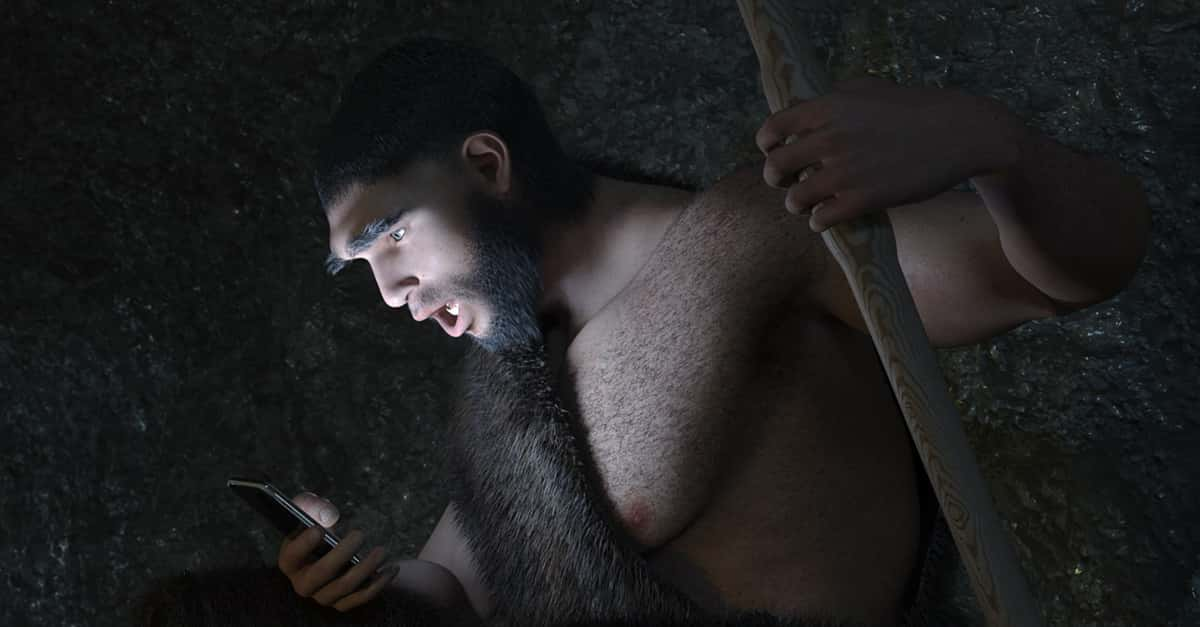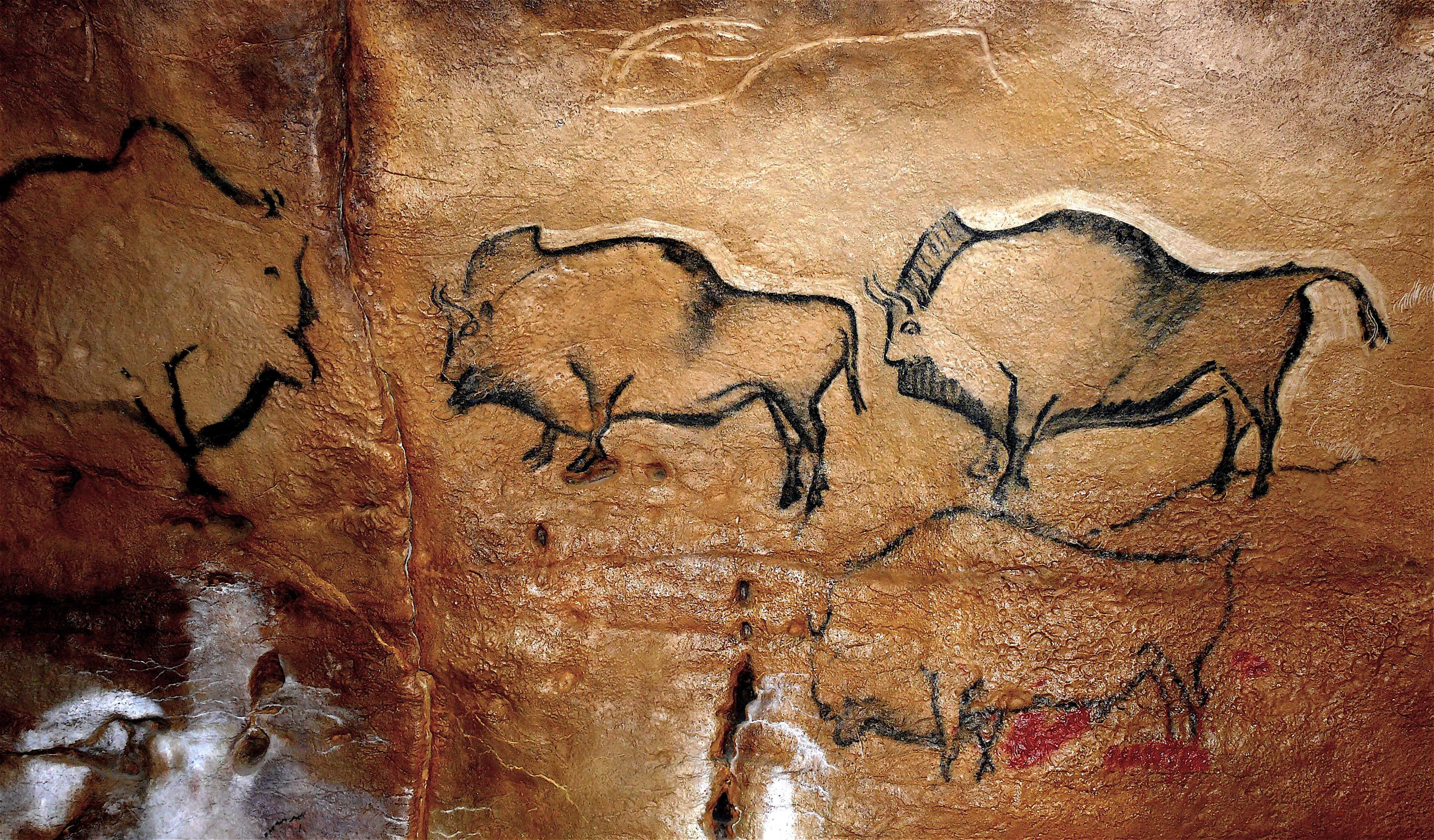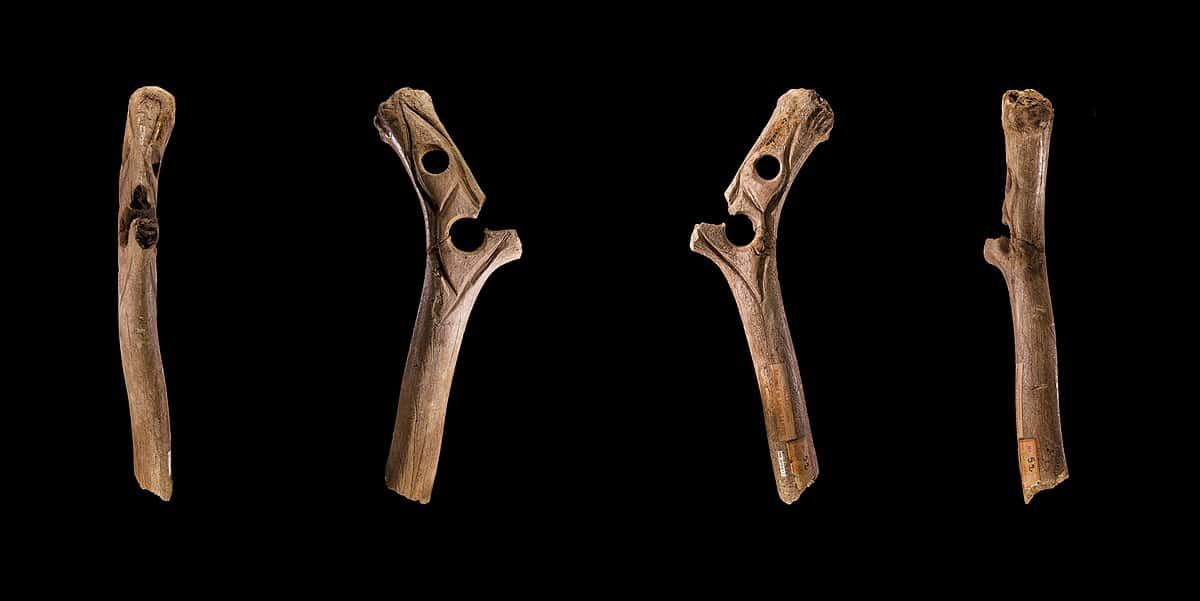"In prehistoric times, Homo sapiens was deeply endangered. Early humans were less nimble, with fewer natural protective mechanisms and less sharpened senses than the predatory creatures they shared their habitat with. Moreover, they were hampered in their movements by the need to protect their uniquely immature young—juicy meals for any hungry beast".—Robert Winston
The more that is uncovered from the past, the more we learn about how similar modern humans are to our prehistoric ancestors. From medicinal practices to tattoos to the DNA, even though technology has vastly changed, not much about who we are has. Covering a wide range of different Homo genus groups, prehistoric humans were able to survive through the toughest of times, yet only Homo sapiens were able to make it to modern day. Good job guys!
39. Fire in the Hole
Prehistoric humans didn’t actually discover fire—instead, it was our previous hominid relatives that likely figured out how to produce a controlled flame. The earliest evidence dates back to our early ancestors, Homo erectus. As the first hominid to walk upright and use tools, evidence suggests that Home erectus was also the first to claim the coveted title of "master of fire". The earliest unearthed fire pits have been found in Africa and date back to around two million years old.

38. Venus in the Ground
Dating back roughly 30,000 years ago, the Venus of Willendorf is one of the first cultural items found during the Paleolithic period. Many other Venus figurines (ancient statuettes portraying a female body) have also been found, and they are believed to have been used as symbolic fertility totems of a mother goddess. Other interpretations suggest they were sensual art, or self-depictions by early female artists viewing their own bodies.
37. Settling In
The earliest evidence of modern humans in Europe is in Southern Italy, sometime between 45,000 to 43,000 Before Present. Between 40,000 to 30,000 BP, the first flutes appear in Germany, Japan, and Hong Kong become settled, and cave paintings in Spain show up.
36. Protein in the Bones
One of the most important food discoveries by prehistoric humans was bone marrow. There isn’t too much to be found when relying on scavenging, but in finding marrow they hit the jackpot, as this became their vital source of protein for a period of time.
35. Healing Clays
Still used by aboriginal people around the world today, applying clay to open wounds was among the first medicines used by humans. As other animals also use clays to treat external injuries, it is believed early humans observed the behavior and applied it to themselves.
34. Genetic Eve
All humans today can be traced back to one female ancestor from about 150,000 years ago. Known as the “Mitochondrial Eve,” she is the most recent common matrilineal ancestor for modern humans, meaning that everyone on earth today is her direct descendent.
33. Blue Eyed Folk
The oldest evidence we have of someone with blue eyes dates back to only 7,000 to 8,000 years ago. Discovered in Northwest Spain, the blue eyes were paired with a dark skin tone, similar to that of modern Sub-Saharan Africans. While blue eyes are rare, they’re even rarer than you think, as analysis indicates that everyone with blue eyes today can be traced back to a single person who lived in that time period. The reason this trait survived is likely because this anomaly was seen as highly attractive and people with blue eyes were able to successfully reproduce.
32. Food Exchange
The Columbian Exchange of food is known for fundamentally changing the way humans eat, as it spread various kinds of now common food (think tomatoes, chocolate) all over the globe and was responsible for the creation of modern cuisine. However, before this exchange, there was an earlier one that changed the world and gave civilization a springboard to develop on: "the Trans-Eurasian Exchange". This exchange circulated different grains, such as millet, wheat, and barley, and molded what would become the Silk Road and dates back to the Bronze Age.
 Shutterstock
Shutterstock
31. Sun Protection
Lighter skin tone only developed in humans about 5,800 years ago, as that is when modern Europeans began to resemble those of today. This occurred as people began living in higher latitudes, which were protected from dangerous UV rays, as opposed to those living in areas with more sunshine and the need for higher levels of melanin to protect from the radiation.
 Wikimedia Commons, Avi1111 dr. avishai teicher
Wikimedia Commons, Avi1111 dr. avishai teicher
30. Scavenger Sapiens
Early humans didn’t really have the hunting skills that we imagine they did. Instead of going directly after large prey, many groups of these prehistoric humans waited until another predator took down a large animal, and then went in afterward to scavenge the remains.
29. Erecting Diaspora
It was over one million years ago now that early human beings actually left Africa, as Homo erectus, and started the prehistoric human diaspora. This seems like a long time to us, but remember kids, that is only a blip on our scale of time.
 Shutterstock
Shutterstock
28. Animalistic Mating
Whether or not humans actually engaged in intimate acts with animals is up for debate (seeing as there weren’t cameras back then), but there certainly is enough prehistoric art displaying the act to show that they at least considered it.
 Shutterstock
Shutterstock
27. Cancerous
Bone cancer has been found in the early human species of Homo Kanamensis. The remains were found in Kenya by one of the world’s leading paleoanthropologists, Louis Leakey, and scientists were surprised to find a lump left by a tumor on the jaw. People tend to think of cancer as a modern disease, but it's been with humanity from the beginning.
26. A Healthy Diet
Like (many) humans today, prehistoric humans consumed a balanced omnivore diet consisting of meat and vegetables. They even had specific cutlery tools for meat and others tools for plants. That's right—even in the prehistoric world you still had to worry about salad forks.
25. Climate Stirs Innovation
The climate on earth goes through periods of change and being able to survive these changes is key to survival. Prehistoric humans were well aware of this and the fossil records show that whenever there was a change in climate, there would be a burst of technological innovation in order to prepare for the shifts.
24. Dental Records
Living on a pre-agricultural, prehistoric diet meant that there were fewer sugars and carbohydrates to affect people’s teeth. This means that prehistoric humans actually had healthier teeth than modern humans do and little need for all the dental work we have done now.
23. Just a Little High
It appears that inhaling smoke has been the method for substance use since such substances became widespread. Early evidence shows that prehistoric humans would inhale hallucinogenic fumes through bowls and tubes in order to enter into spiritual trances. Like, far out man!
22. Partying with Friends
Prehistoric people weren't purely engaging in substance use; they were also indulging in consumption of liquids. A site dating back to 11,000 years ago in Cyprus has been uncovered, which was used as a ceremonial site... and as a brewery. In fact, evidence suggests that the function of brew was used just as it is today by most—as a social lubricant.
21. Entering into History
Historians agree that "Prehistory" ended when written language was invented.
But because written language was invented at different times all around the world, prehistory is considered to have ended at different times for different countries.
For example: writting appears in Egypt around 3200 BCE. But in New Guinea, written language didn't arrive until the first visits of European explorers, in about 1600 AD. Meaning New Guinea's prehistory didn't until about 5000 years after prehistory ended in Egypt.
20. By The Ages
For a while, it was common for historians to separate ancient and pre-ancient history into a distinct three-age system: The Stone Age, the Bronze Age, and the Iron Age. They were based on when new tool technology developed.
But even though many of us still know these terms, serious anthropologists no longer use them.
For example: The "stone age", as we once called it, is now more commonly split into the Paleolithic era, or Old Stone Age (in which early Homo sapiens emerged around 200,000 years ago), the Mesolithic, or Middle Stone Age, and Neolithic, or New Stone Age.
It's a more confusing system, but it's also much more detailed and accurate. The names aren't nearly as catchy, though.
19. Free Love
With agriculture came ideas of property and inheritance. Before this, however, males did not think much about paternity—and neither did females. To enhance their probability of reproduction, females frequently maintained multiple intimate partners, with the idea of exclusive monogamy not always being prevalent. It wasn't until people began owning things to be passed down to their children that all of a sudden "whose kid is whose" became a big deal.
18. Population Crash
Effective population is different than actual population size, as it measures genetic diversity in a population of species. Around 80,000 years ago, for some reason, the effective population size of humans dramatically decreased, essentially crashing, and it still hasn’t recovered, and scientists still do not know exactly why.
17. Life After Fire
Since we didn’t discover fire, that means that Homo sapiens have never actually lived without controlled fire in our lives—talk about creature comforts. While the Millennials are the first to be born into the digital age without knowing what life without a computer is, the first Homo sapiens had perhaps an even more incredible advantage. And don't get them started on avocado toast!

16. Old Man Homo Sapien
For a prehistoric human, the average lifespan was only about 35 years. However, this does not mean they didn’t live long, healthy lives. With an enormously high infant mortality rate, this average is drastically scaled down compared to today—archaeological evidence shows that it was not completely uncommon for people to live at least into their 70s.
15. Nonlinear History
Neither history nor evolution necessarily progresses in a linear manner. With the rise of prehistoric humans, many Homo genera lived on earth together. That means that early Homo sapiens lived alongside such cousins as the Homo floresiensis as recently as only 15,000 years ago.
 Unknown author, CC BY 4.0 , Wikimedia Commons
Unknown author, CC BY 4.0 , Wikimedia Commons
14. Must Love Dogs
Speaking of 15,000 years ago, evidence shows that this was about the same time that prehistoric humans first domesticated man's best friend. While there are conflicting theories about how and why wolves and humans engaged in a mutually beneficial relationship, it is known that the Eurasian gray wolf was the first to be domesticated.
 Pxfuel
Pxfuel
13. Sleeping with Species
Not only did Homo sapiens live with other subspecies, but they also got it on with them. While Neanderthals and prehistoric humans roamed around Europe 80,000 to 30,000 years ago, they engaged in reproductive activities with each other leading to interbreeding. This wasn't an uncommon event either, as humans would frequently engage in intimate relations with other species of hominid.
12. Hybrid Babies
While Neanderthals and Homo sapiens were able to interbreed, it is believed that only in the females humans were eggs able to be fertilized. Because of this, many modern humans have part of the Neanderthal genome inside of them to this day. This happened after Homo sapiens migrated out of Africa and began living alongside their more primitive cousins in Europe.
11. Taste for Fashion
Neanderthals were not only able to master toolmaking ahead of other species, but they also conducted burial rituals with ornamented grave sites for their departed members.
In addition to all that, they even wore jewelry, which they would fashion out scallop and cockle shells before painting.
So there you go. We might think of them as primitive cavemen today... but they were actually pretty ahead of their time, as far as the Homo genus is concerned.
Go figure.
10. Adventure Beings
Homo sapiens are distinguished from other species for a wide range of reasons, but one of the most fundamental and intriguing ways is in their exploratory nature. Homo sapiens and only Homo sapiens ventured out into the open seas and traveled across the water in search of new land. Other species simply stopped once they hit water, limiting them to Europe and Asia.
 Wikimedia.Commons
Wikimedia.Commons
9. Trial and Error to Easter Island
It was about 50,000 years ago that Homo sapiens began traveling to Australia and populating the continent. They did so on small boats made out of reeds. We can only imagine how many attempts were made relative to the success stories of those who arrived. Just think about that next time you complain about having to take the bus.
8. Construction Job
Though they were primitive, Homo Sapiens Neanderthalensis (or Neanderthals as we like to call them) were actually responsible for humanity’s earliest construction projects, dating back to over 175,000 years ago.
Set inside caves, they built mounds and rings out of stone (like a miniature Stone Henge) which experts believe may have been for religious purposes.
Not so stupid, eh?
7. Community Communication
A large part of why prehistoric humans were able to survive and outlive other groups of hominids was that their brains had the capacity to communicate abstractions. Many other primate groups had (and have) the capacity to communicate concrete concepts or conceptualize identity, but it is believed that it was the Homo sapiens' ability to discuss abstract concepts that led to the formation of stronger bonds and tighter communities, which worked effectively in a symbiotic manner in order to survive.
6. Words, Words, Words
Moderns researchers have been able to go back and restructure some of the prehistoric languages and shockingly found that some of the words used are strikingly similar to our modern vocabulary. One theory posits that words such as "hand" and "fish" were conceptually derived from words used 15,000 years ago during the Mesolithic period. We call these words “cognates,” which means that they are words which have been preserved through history and are used across many different cultures.
5. Cultural Times
The Upper Paleolithic was also the time period when the earliest settlements began to be organized and culture emerged, as well as cooperative planning. As evidence suggests a new form of coherent communication which displays a greater sense of foresight and long-term planning, it's believed that it was during this time when complex language developed.
4. Beneath the Stone Blade
Brain surgery is a risky endeavor. Now imagine prehistoric brain surgery. Sure, sounds like maybe the biggest risk a prehistoric human could take, but not only was it practiced, but evidence suggests that it was even quite successful. Trepanation, or in simpler terms, drilling a hole in a person's skull, has been done for various reasons for over 10,000 years, but it might not have always been that crazy of idea. The procedure can actually release pressure on the brain in case of injury, and might (rarely) have actually been beneficial. Skulls found with primitive surgery marks, and evidence of bone tissue regrowth, date back to 8,000 BCE.
 Shutterstock
Shutterstock
3. Debates on Intimate Toys
Dating back to the Upper Paleolithic Era (50,000-10,000 years ago), the Bâton de commandement is a prehistoric artifact found throughout the Western European continent whose function has been widely debated. Pieces of antler carved in a T or Y shape with a hole in it, no one is quite sure what they were used for, but one theory was that they were prehistoric intimate toys. As British archaeologist Timothy Taylor reasons, “Looking at the size, shape, and—some cases—explicit symbolism of the ice age batons, it seems disingenuous to avoid the most obvious and straightforward interpretation. But it has been avoided".
2. Early Stitches
One form of prehistoric surgery used ants in order to sew up wounds. Primarily used in the Americas, people would hold an ant above an open wound and wait for it to bite the skin with its pincers. Once bitten, the head would be removed so that the pincers would stay in place as a stitch.
1. Tattooed Mummy
Found in 1991 in the Ötztal Alps, Ötzi “the Iceman” is the earliest natural human mummy ever discovered in Europe. Alive from sometime between 3400 and 3100 BCE, the most surprising thing about his body was that he had tattoos. And not just one or two, but 61 different tattoos in total, making him the oldest tattooed mummy ever found. The tattoo ink was produced from ash or soot and is believed to have been used of a form of pain relief.
Sources: 1, 2, 3, 4, 5, 6, 7, 8, 9, 10, 11, 12, 13, 14, 15, 16, 17




































